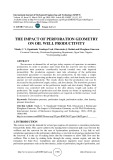
http://www.iaeme.com/IJMET/index.asp 1900 editor@iaeme.com
International Journal of Mechanical Engineering and Technology (IJMET)
Volume 10, Issue 03, March 2019, pp.1900-1909. Article ID: IJMET_10_03_193
Available online at http://www.iaeme.com/ijmet/issues.asp?JType=IJMET&VType=10&IType=3
ISSN Print: 0976-6340 and ISSN Online: 0976-6359
© IAEME Publication Scopus Indexed
THE IMPACT OF PERFORATION GEOMETRY
ON OIL WELL PRODUCTIVITY
*Onuh, C. Y, Ogunkunle Temitope Fred, Oluwatosin J. Rotimi and Efeoghene Enaworu
Covenant University, Petroleum Engineering Department, Ogun State, Nigeria.
*Corresponding author
ABSTRACT
The increase in demand for oil and gas today requires oil operators to maximize
productivity. In order to produce more fluid from the reservoir into the wellbore,
perforations must penetrate considerably beyond invaded zone with impaired
permeability. The production engineers must take advantage of the perforation
controllable parameters to maximize the well productivity. In this study, a simple
analytical model incorporating perforation length, radius, and shot density was used to
analyze oil well productivity. The results shows that the production rate can be
increased by the perforation length, radius, and shot density. The drawdown pressure
was reduced with increase in the perforation length and shot density. Higher fluid
velocity was controlled with increase in the shot density, length and radius of
perforation. The length of perforation and shot density are better in optimizing well
productivity. Optimum perforation parameters are required as further increase result
in increase in cost relative to the productivity.
Keywords: Perforation pressure, perforation length, perforation radius, shot density,
pressure drawdown.
Cite this Article: Onuh, C. Y, Ogunkunle Temitope Fred, Oluwatosin J. Rotimi and
Efeoghene Enaworu, The Impact of Perforation Geometry on Oil Well Productivity,
International Journal of Mechanical Engineering and Technology, 10(3), 2019, pp.
1900-1909.
http://www.iaeme.com/IJMET/issues.asp?JType=IJMET&VType=10&IType=3
1. INTRODUCTION
The current trend in the demand for oil and gas requires oil operators to maximize production
from prolific fields. This can be achieved by making better connection path ways between the
wellbore and the reservoir for the ease of hydrocarbon production. A key link in well
completion operations is the perforation which plays a vital role in oil and gas production from
the reservoir. It is the act of making holes into the formation to allow fluid flow into the
wellbore. This is done by making holes through the casing, cement region, and into the
formation for fluid flow. Completion and production engineers must ensure optimum
perforation parameters such as the shot density, radius of perforation, length of perforation, and





















